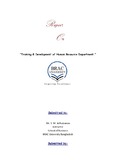| dc.description.abstract | All the successful companies and conglomerates of today have one feature in common: they all have a very competent Human Resource Department (HRD). The function of this department is to ensure improved business performance and competitive advantage by attracting, developing and retaining people in an organization in an effort to build organizational capabilities to meet the strategic objectives of the business. As a popular slogan puts it ¡§Assets make things possible, people make things happen.¡¨ Hence, it is not surprising that organizations strive so hard to manage their human resources so efficiently and effectively. The key HR functions are:
„X HR planning
„X Recruitment and Selection
„X Orientation, Placement and Separation
„X Training and Development
„X Performance Appraisal
„X Compensation and Protection
„X Employee Relations and Assessment
This report deals with just one of these activities ¡V Training and Development. The training and development process is basically one which transforms new/unskilled workers into a skilled, committed and motivated workforce. While training helps employees do their present jobs, the process of development helps individuals handle future responsibilities. Organizational Development (OD) attempts to bring about a positive, planned change in the organization through behavioral, structural or technical strategies.
Now, here in Bangladesh, a developing country, many companies still operate without a distinct HRD. Thus, one of the country¡¦s strength ¡V its manpower- is often underutilized. Even the companies which do have a HRD, training and development often do not gain as much importance as it should. So what exactly is the present scenario in Bangladesh? How is the function of training and development carried out in Bangladeshi firms? This report attempts to answer these questions. But then again, training and development is that HR activity which is very industry specific, at times even company specific. The way Training and Development is carried out in a manufacturing firm is quite different from that in a merchandising firm or a firm operating in the service sector. So, delineating the T&D process in any one company would not do justice to this report. Hence this report attempts to reveal the current T&D scenario in Bangladesh by portraying the training and development processes in an industry. In the garments industry, NASSA Group is currently one of the major players. Thiscompany, being manufacturing firms, focus primarily on the training of their factory workers. In NASSA Group the training needs are determined by both the HR manager and the concerned department’s supervisor. Also an Industrial Engineering (IE) Department which is solely responsible for continuously assessing the needs of the workers in the factory. The IE Department has a modern training center where there is an IE-in-Charge who supervises the Head Trainer. This Head Trainer in turn oversees the calculation trainer, scientific motion trainer and the sew data motion instructor. The training center has all the workplace equipment that machine operators use in the factory. It also has safety gear and equipment found within the factory, to help workers get acquainted with the safety hazards in the workplace. In short, the training and development activity in NASSA Group is very structured and totally in-house. In this activities are mainly on the job and include apprenticeships and physical training. However, off-the-job training like classroom lectures does occur as well. Quite unfortunately, the HRD of neither of the one garments seem to give training and development adequate importance. Selection, Compensation Packages and Performance Appraisal are deemed to be the more important HR tasks in NASSA Group and thus take precedence over the training and development of employees. In NASSA Group, once the training supervisor receives the Training Requisition Form signed by the department head, he begins to prepare the training resources which include lecture sheets, equipment manuals, technology handbooks, audiovisuals and suitable trainers. The trainers used by NASSA include both ‘peer trainers’ and executive trainers who too are first trained through a “Train the Trainer” workshop. There are 3 level of training in NASSA Group. Once the trainer is done training, the trainees’ post-training performance is evaluated by observing changes in productivity, and absenteeism and turnover rates. The trainees also give feedback about the training process so that there is room for improving the entire process.Operations, maintenance and quality control (QC) are the three sections where employees of NASSA need a lot of training. The job skills training conducted here include safety tour and guidelines, factory overview and tour, job knowledge transfer, job observation, proficiency tests and so on. When it comes to office staff and executives, it has been seen that NASSA Ltd does complete outsourcing of its training needs. No executives are given in-house training. This responsibility is outsourced to competent organizations like Bangladesh Institute of Management (BIM), Chittagong Skills Development Centre (CSDC), and Rapport Bangladesh Limited. Section and Department Heads are also sent to countries like India, Hong Kong, Switzerland, Italy, Japan and Germany for training. By contrast, training and development of office staff in NASSA is a combination of both on-the-job and off-the-job techniques. Employees are often sent to attend seminars and workshops in Bangladesh Society for Human Resource Management (BSHRM) and DaniResourcesCenter. However, here too, officials are sent for overseas training if the Board of Directors deems it to be necessary. The manufacturing process in NASSA is line based, and each line occupies a whole floor. As part of its development program, NASSA has a pilot project titled the “Modular Floor.” This project is conducted on highly trained operators. They are made to work without any assistance from any helpers or supervisors. This reduces cost without compromising productivity or quality. The pilot project has proved to be a very successful scheme, and so NASSA has plans of applying this concept factory-wide. By giving training to all of its employees, NASSA aims to make this transformation come true. | en_US |

